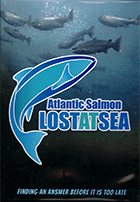
Atlantic Salmon: Lost at Sea 2017
Distributed by Green Planet Films, PO Box 247, Corte Madera, CA 94976-0247; 415-377-5471
Produced by Deirdre Brennan for Castletown Productions
Directed by Deirdre Brennan, Éamon de Buitléar
DVD , color, 55 min.
High School - General Adult
Fisheries, Wildlife Conservation, Ecology
Date Entered: 11/02/2018
Reviewed by Cliff Glaviano, formerly with Bowling Green State University Libraries, Bowling Green, OHThe Atlantic salmon commercially available in the US are farm raised. Wild Atlantic salmon returning to their home rivers to spawn after 3 years at sea are down 70 percent. Since Atlantic salmon in North American waters evolved in their DNA to specific home rivers, they have gone extinct in more than 300 rivers since 1948. Though wild and farmed Atlantics can mate, the hybrid wild/farmed salmon are not as viable in the open ocean environment. Juvenile salmon, or parr, remain in their home rivers from 1 to 6 years. Young salmon, the smolts, leave their rivers to mature in the waters west of Greenland.
So, where do 70 percent of the Atlantics disappear? The rivers are full of parr. The SALSEA international research project found that warming waters tend to influence smolts to leave their home rivers earlier and at a smaller size. Since more than 90 percent of the smolts reach the ocean to feed on plankton, and later on capelin, a preferred forage fish, scientists feel that predation alone is not high enough to account for the millions of salmon lost at sea. Young salmon captured before gaining their Greenland feeding waters were thin and undernourished, likely due to plankton moving north of the salmon’s migration routes in warming ocean currents. Commercial fishing for wild Atlantic salmon has been banned in the North Atlantic since 1981. Highly regulated sport fishing for Atlantics is allowed in Canada, Iceland, Scotland, Ireland and Scandinavia.
This comprehensive overview of the plight of wild Atlantic Salmon is highly recommended. The film frames a discussion of the problems posed by overfishing, habitat restriction by river damming, and the more subtle influences of commercial aquaculture and global warming. It also makes a good case for maintaining genetic diversity, even within a single species. It depicts contemporary methodologies for fisheries research and the successful results of barrier removal projects, a dam removal in Maine, and a fish ladder in Iceland. This film would be excellent for stimulating discussion, or serving as a background resource, for many environmental topics.